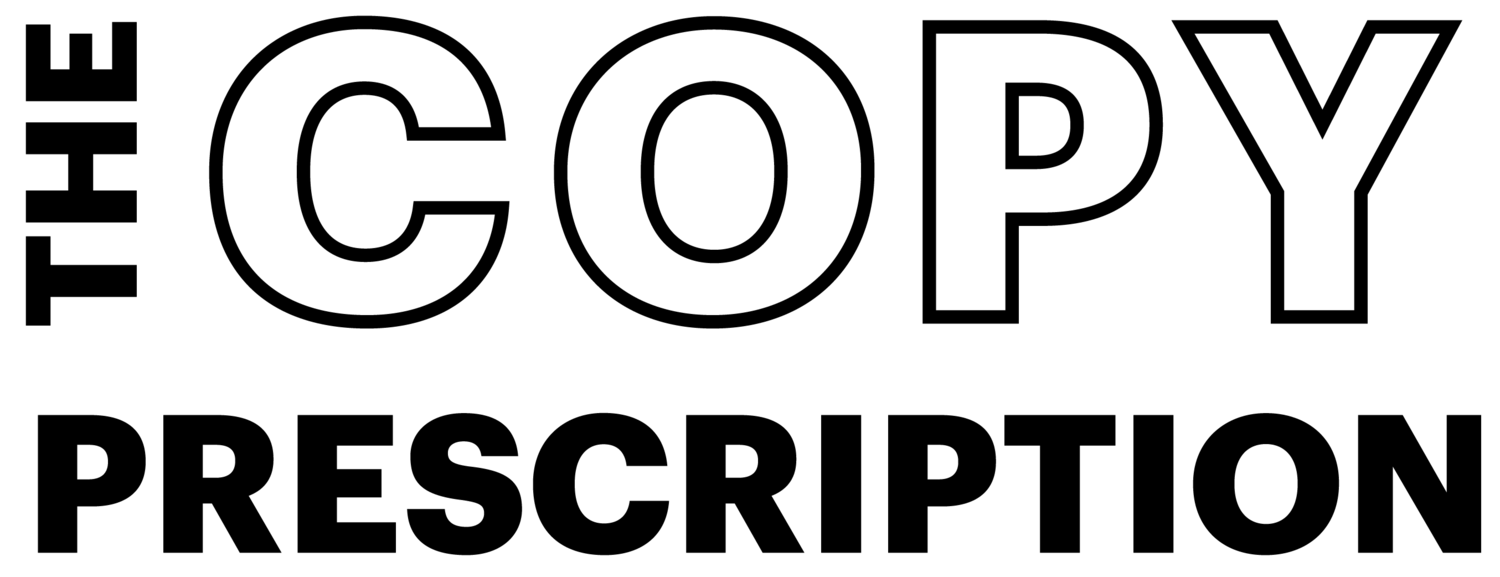Harness the power of bold copy for your health brand
Go bold or go home. Sort of.
What do a couple of burly bouncers singing nursery rhymes, an empty bucket of fried chicken, and an outdoor retailer opting out of Black Friday have in common?
They’re all examples of bold copy – brands taking risks with advertising copy by side-stepping convention and prodding the socially comfortable boundaries of language, voice and theme.
I mention this because last week, I found myself enjoying a slice of pizza and a cheeky Pinot Grigio on a moored barge, at a networking event for local copywriters (I know, it writes itself). Shout out to our generous hosts from DMA and Leith.
The theme, 'writing bold copy', was illustrated through a full deck of brilliant, clever and hilarious ads that prompted many a murmur of 'ugh, I wish I wrote that'.
A couple of my faves:
I thought the KFC apology was ingenious – diffusing disgruntlement with playful, on-brand humour and humility (in case you don’t know the story, they ran out of chicken in a number of UK restaurants. As they said, not ideal).
And the stomach-churning octopus copy featured in the ad for Hellman’s mayo was inspired – who would think of mentioning tentacled brain sacs in a foodie ad, never mind eating them for lunch?
So what IS bold copy?
In the discussion about how we use copy to challenge and provoke, to be a little off-beat and yet still play to the audience, it occurred to me that boldness is definitely in the eye of the beholder.
For some brands, bold copy means strong, confident writing that evokes an immediate reaction in the reader – maybe a little shocking, definitely memorable. For others, it’s about taking things in a different direction from competitors, using humour or tone in a way that surprises the reader, or dancing along the line of acceptability without totally crossing it.
For others still, it might be as simple as using a conversational tone instead of stuffy corpspeak.
And what catches the attention of some audiences might be boring as shit for others. Risqué to one might be plain offensive to another. All of these perspectives are valid.
So how do we walk that line?
Bold copy means taking a risk
I always tell my clients they should be excited to draw a line in the sand with their copy because anyone who’s turned off wasn’t an ideal customer anyway. The ones that vibe with it will only love them more.
It’s a differentiator – if you play it safe and try to please everyone, you’ll end up with the same ‘best value for you’ drivel that everyone else is putting out there.
But of course, there's a balance to be struck.
For instance, I wasn't sure the ad for a hardware store that played on the stereotypical shopping habits of men and women worked as well as an example of 'bold' as some of the others. This mischievous humour might resonate perfectly with the target audience, which would definitely make it successful copy by one measure. But it risks feeling like something conjured up in Don Draper's man bubble (now there's an image).
What if the campaign focused on women instead (who, as my partially renovated kitchen suggests, are spending plenty of their hard-earned cash on paint and plywood)? Now THAT would have been bold - an unexpected move in a traditionally male industry, setting themselves apart from their power-tool peddling competition.
Raising the bar for boldness is an opportunity to move away from tired tropes and eye-rolls, to encourage your audience to think differently, and even reach new audiences.
This is why being bold in your copy means taking a risk. It might be in the words. Or it might be in the courage of the client or copywriter in being willing to test limits and try something new. Sometimes you'll get it right, and sometimes you might not.
(But let’s avoid naff stereotypes, even if some of your audience buys into them.)
How to write bold copy for your health brand
Ok, I said this was about bold copy for health brands, and finally I'm getting to the point!
The thing about health copywriting (that makes it different from many other industries) is that we’re often trying to communicate tricky concepts that are rooted in science, through the lens of a deeply personal customer experience. If you're in the business of helping people improve their health, you'll know it's hard to make some of this stuff sound sexy.
The call of clickbait is strong.
Recently I posted on LinkedIn that in order to capture customer attention, sometimes health brands have to give customers a little of what they want in order to give them what they need. I think this is especially true with fitness and nutrition, which are highly trend-driven. A bolder move might be to straight out give them what they need, and forget the rest.
It’s a judgement – you need to know your brand, and know your audience. If bold for you is dropping the 'Dear Sir/Madam' and incorporating a few contractions, well, start there!
Some ideas to get you started:
use humour to highlight a serious issue and get people talking
use a conversational tone to give your straight-laced organisation a more human face
brighten up your copy with unexpected descriptions to make the reader stop and take notice (like the tentacle thing!)
keep it simple by getting straight to the point with unexpected honesty
go long, with emotion-driven storytelling and characters
use unusual images to put an unconventional spin on your copy
play around with voice, formatting and calls to action
look at what others in your field are doing, and do the opposite
or work with a really awesome copywriter to help you nail the perfect words (well, hello there!).
Be brave, strategic and relevant. Don’t be rude (ok, be a little rude).
And remember, clarity beats boldness. Don’t let clever get in the way of clear.
What would bold copy look like for your health business?
Want my eyes on your copy? Get in touch.
(📷: @trommelkopf via Unsplash.)











